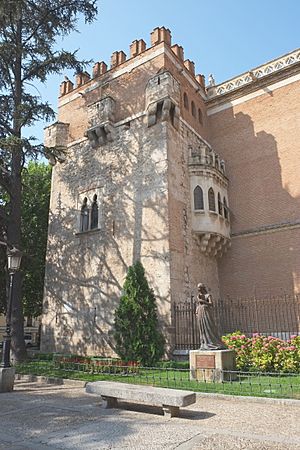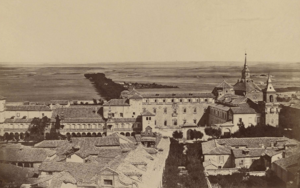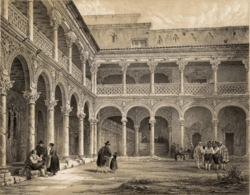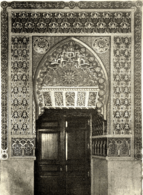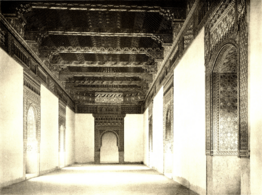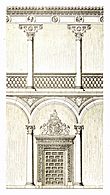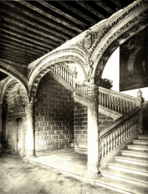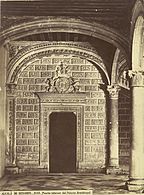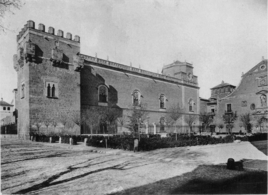Archiepiscopal Palace of Alcalá de Henares facts for kids
Quick facts for kids Archiepiscopal Palace of Alcalá de Henares |
|
|---|---|
| Native name Spanish: Palacio Arzobispal de Alcalá de Henares |
|
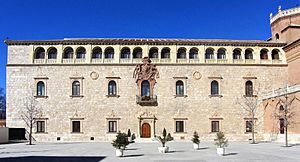
The Archiepiscopal Palace today.
|
|
| Location | Alcalá de Henares, Community of Madrid, Spain |
| Official name: University and Historic Precinct of Alcalá de Henares | |
| Type | Cultural |
| Criteria | ii, iv, vi |
| Designated | 1998 |
| Reference no. | 876 |
| Session | 22nd |
| Region | Europe and North America |
| Official name: Palacio Arzobispal de Alcalá de Henares | |
| Type | Monument |
| Designated | 1931 |
| Reference no. | RI-51-0000727 |
| Lua error in Module:Location_map at line 420: attempt to index field 'wikibase' (a nil value). | |
The Archiepiscopal Palace of Alcalá de Henares (in Spanish: Palacio Arzobispal de Alcalá de Henares) is a grand palace. It is located in Alcalá de Henares, a city in the Community of Madrid, Spain. Today, it is the main office for the Diocese of Alcalá de Henares.
The palace stands in the Plaza del Palacio. This area is part of a larger historical site. It was named a World Heritage Site by UNESCO. The first parts of this building complex were built in 1209.
Sadly, a huge fire in 1939 destroyed two-thirds of the palace. This happened during the Spanish Civil War. Only the parts that were not damaged by the fire remain today. The destroyed sections were never rebuilt.
Many important people have lived in this palace. It hosted different Castilian kings and queens. Important meetings and councils also took place here. Two famous people were born in this palace. One was Catherine of Aragon, the youngest daughter of the Catholic Monarchs. She later became queen of England. The other was Ferdinand, son of Joanna "the Mad". He became the German Emperor. The palace is also famous for a very important meeting. It was here that the Catholic Monarchs first met Christopher Columbus.
Contents
A Look Back: The Palace's Story
The palace started as a Mudéjar fortress in 1209. Archbishop Rodrigo Ximénez de Rada ordered it built. It was meant to be a temporary home for the archbishops of Toledo. Alcalá was part of their archdiocese, which is why it got its name. The palace has faced many fires and damages over time. It has been rebuilt and changed many times to look as it does today.
In 1348, important meetings called the Courts were held here. They passed the Ordinance of Alcalá. This law helped to make justice the same across all lands in the Crown of Castile.
In 1308, two kings met at the palace. They were Ferdinand IV of Castile and James II of Aragon. They signed the Treaty of Alcalá de Henares. This treaty divided the lands taken from the al-Andalusian Taifas during the Reconquista.
Later in the 14th century, Archbishop Pedro Tenorio (1377-1399) rebuilt the palace. He made it stronger like a fortress. He added a large rectangular courtyard for parades. It was over 2 hectares in size. Walls with 21 towers surrounded it. Most towers were rectangular. One was pentagonal, and another was semicircular. Today, 16 towers remain. The "Tower of Tenorio" is very famous, named after the Archbishop.
In the 15th century, Archbishop Juan Martínez Contreras (1423-1434) added the east wing. It had large Gothic windows. He also built the Anteroom and the Hall of Councils. These two rooms were connected by a grand arch. They had amazing Gothic-Mudéjar wooden ceilings.
On January 20, 1486, a very important meeting happened here. Queen Isabella I of Castile met Christopher Columbus for the first time. They discussed funding his trip to the Indies.
In 1524, Archbishop Alonso de Fonseca y Ulloa (1523-1534) hired architect Alonso de Covarrubias. He asked him to build the west wing. This included its courtyards and a magnificent staircase. His successor, Cardinal Juan Pardo de Tavera (1534-1545), finished the work.
For many years, the palace housed important archives. These were the records of the Toledo diocese. Later, it stored documents for notary clerks and judicial income. From 1858 to 1939, it was the Central General Archive of Alcalá de Henares.
The Central General Archive was created in 1858. This was because the Archivo de Simancas was full and far from Madrid. The Archbishop's Palace was given to the State for this purpose. It held documents from government ministries. These documents were later sent to the National Historical Archive. On August 12, 1939, a fire destroyed the Central General Archive. The General Archive of the Administration (AGA) in Alcalá de Henares took its place in 1969.
Since 1991, the palace has been the main office and home for the bishop of the Bishopric of Alcalá de Henares.
The Devastating Fire of 1939
During and after the Civil War, the Archbishop's Palace was used as a barracks. It stored tanks and ammunition. Sadly, flammable materials were not removed. This led to a huge fire on August 11, 1939. It was not the first fire in the palace's long history. But it was one of the worst. It destroyed much of the buildings and many historical documents. These documents had been kept there for three centuries.
Many artistic treasures were lost in the fire. These included the beautiful Mudéjar wooden ceiling of the Hall of Councils. The grand staircase by Covarrubias was also destroyed. Other losses included the Fonseca courtyard, the Hallelujah courtyard, and the Ave Maria facade. Many paintings and the city's first archaeological museum were also lost.
The Palace Today
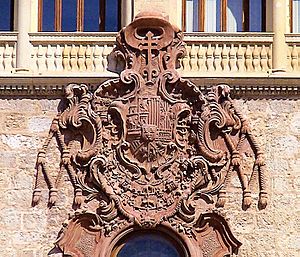
The palace has gone through many changes and repairs. The fire of August 11, 1939, was especially damaging. It destroyed two-thirds of the building. This included three courtyards: "the Fonseca" (or "the Covarrubias"), "the Hallelujah," and "of the Fountain" (or "the Small garden"). The "Staircase of honor" and the "Facade of the Ave Maria" were also lost. This facade was in the Herrerian style. The "Garden of the Vicar" was also destroyed. Repairs on the less damaged parts were finished in 1996.
Today, the palace has 16 towers. The "Tower of Tenorio" is a highlight. When you enter the parade courtyard, you see the main Renaissance facade. It has two main parts. The lower part is made of stone blocks. It has two floors with Plateresque windows. Above them is a gallery with twin arches. A Baroque terracotta coat of arms is above the central window. This replaced the imperial coat of arms of Charles V, Holy Roman Emperor. The coat of arms belongs to Cardinal-Infante Luis Antonio of Bourbon. He was the son of Philip V, the first Bourbon king. This courtyard is closed on the south side by a cast iron gate. It was made in Belgium in the 19th century.
In the east wing, where the "Hall of Councils" used to be, a big restoration happened in the 19th century. Juan José Urquijo and Manuel Laredo worked on it. They followed the Neo-Mudéjar style. In 1997, a restored neo-Gothic chapel opened. It replaced the lost Hall of Councils. On the lower floor, a modern auditorium was built. It replaced the "Hall of the Queen Isabella."
Lost Parts of the Palace
-
Courtyard of Fonseca.
-
Staircase of Covarrubias.
-
Inner door with the coat of Tavera.
Antiquarium Museum
After the fire, some parts of the Archbishop's Palace were rebuilt. Others were restored. Work continues to save more of these historical treasures. You can enter the Antiquarium through Tower XIV. Here, you can see some of the recreated parts. These include sections of the Ave Maria galleries, the large Courtyard of Fonseca, and the Covarrubias Staircase.
For many decades, the play "Don Juan Tenorio" by Zorrilla has been performed in Alcalá. It takes place in several historical monuments. The Archbishop's Palace is always one of them. Some years, the play has even been performed only at the palace.
The Antiquarium is an outdoor museum. It is located inside the walled area of the palace. You can reach it through the fourteenth tower.
Why the Name "Archiepiscopal Palace"?
The Archbishop's Palace gets its name from its history. For eight hundred years, Alcalá de Henares was under the control of the archbishops of Toledo. These archbishops were the most important religious leaders in all of Spain. They had their main home here. This meant that Alcalá de Henares was a center of religious power for centuries. For a long time, religious power was also linked to political power.
Famous People Connected to the Palace
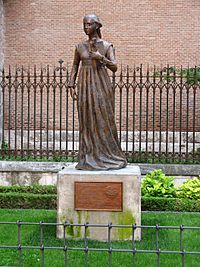
Monarchs Born or Lived Here
Many members of the royal court lived and died in the Archbishop's Palace. This includes Castilian King John I. He died here in 1390 after falling from his horse nearby. Other monarchs used it as a temporary home. For example, the Catholic Monarchs stayed here. Their daughter, Catherine of Aragon, was born in the palace. She later became queen of England when she married Henry VIII of England. Ferdinand I, Holy Roman Emperor was also born in this palace. He was the son of Joanna the Mad. He became the Holy Roman Emperor after Charles V.
Other Important People Who Died Here
- Jimeno Martínez de Luna (died 1338): An Archbishop.
- Sancho de Rojas (1372 - 1422): An Archbishop and military leader.
- Juan Martínez de Contreras (died 1434): An Archbishop and lawyer.
- Alfonso Carrillo de Acuña (1410 - 1482): An Archbishop.
- Alonso III Fonseca (1475 - 1534): An Archbishop.
- García Loaysa y Girón (1534 - 1599): An Archbishop and writer.
The Palace in Movies and Documentaries
Parts of the Archbishop's Palace have been used as filming locations. Many movies and documentaries have been recorded here.
Movies
- 1918: Los intereses creados by Jacinto Benavente and Ricardo Puga
- 1928: El guerrillero by José Buchs
- 1931: Isabel de Solís, reina de Granada by José Buchs
- 1934: El agua en el suelo by Eusebio Fernández Ardavín
- 1943: El escándalo by José Luis Sáenz de Heredia
- 1960: La rana verde by José María Forn
- 1967: Sor Citroen by Pedro Lazaga
- 1972: Carta de amor de un asesino by Francisco Regueiro
- 1972: ¡Qué nos importa la revolución! by Sergio Corbucci
- 1973: Lo verde empieza en los Pirineos by Vicente Escrivá
- 1974: Una pareja... distinta by José María Forqué
- 1977: Paraíso by Miguel Luxemburgo (José Miguel Ganga)
- 1986: Dragón Rapide by Jaime Camino
Documentaries
- 1935: Alcalá de Henares by Daniel Jorro
- 1943: Alcalá de Henares by Francisco Mora
- 1946: Alcalá, la cervantina by Juan A. Durán
- 1946: Compluto Alcalá de Henares by Luis Meléndez Galán
- 1970: Alcalá de Cervantes by Raúl Peña Nalda
- 1971: Ruta colombina by Augusto Fenollar
- 1992: Sueños de fortuna by Pedro Martínez Oses
- 2013: El Palacio de los Arzobispos de Toledo en Alcalá de Henares by Gustavo Chamorro Merino and Ángel Pérez López
See also
 In Spanish: Palacio arzobispal de Alcalá de Henares para niños
In Spanish: Palacio arzobispal de Alcalá de Henares para niños


